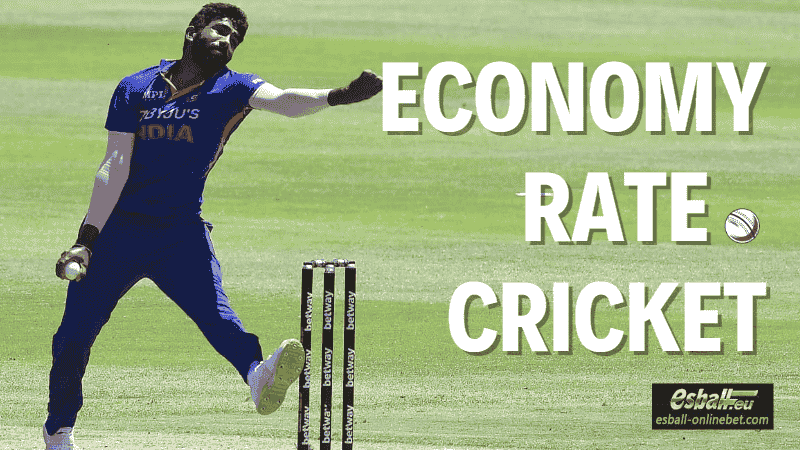Content
What's E/R Meaning in Cricket? "E/R" stands for "economy rate," and is specific to the sport.
How to calculate economy rate in cricket? In cricket, the economy rate refers to the average number of runs conceded by a bowler per over bowled. It is a key statistic used to assess a bowler's effectiveness in restricting the scoring of runs by the batting team.
The calculation involves dividing the total runs conceded by the total number of overs bowled and is typically expressed as runs per over.
On the other hand, in economics or finance, the term "economy rate" generally refers to the rate at which goods and services are produced, exchanged, or consumed within an economy.
It's a measure of the efficiency of resource utilization within an economic system and is usually expressed as a percentage change in a particular economic indicator over a specified period of time.
So e/r meaning in cricket does not directly relate to the broader concept of economy rate in general contexts such as economics or finance.

E/R Meaning in Cricket
In cricket, "e/r" typically stands for "economy rate." The economy rate is a statistic used to measure the effectiveness of a bowler in limiting the number of runs scored by the batting team.
It is calculated by dividing the total number of runs conceded by the number of overs bowled and is usually expressed as runs per over.
A lower economy rate indicates that the bowler is conceding fewer runs per over, which is generally considered favorable for the bowling team.
E/R Of 5 Famous India Bowlers in Cricket
Here are some examples of famous Indian bowlers along with their economy rates in cricket for reference after we learn the E/R meaning in Cricket:
- Anil Kumble: An iconic Indian leg-spinner known for his accuracy and variations.
Career Economy Rate: Approximately 2.69 runs per over. - Jasprit Bumrah: A modern-day Indian fast bowler renowned for his unconventional action and pinpoint yorkers.
Career Economy Rate (as of 2022): Approximately 4.56 runs per over. - Ravichandran Ashwin: A prominent Indian off-spinner known for his ability to outthink batsmen.
Career Economy Rate (as of 2022): Approximately 2.91 runs per over. - Kapil Dev: India's legendary all-rounder who was a pace bowler and a hard-hitting batsman.
Career Economy Rate: Approximately 3.71 runs per over. - Zaheer Khan: A left-arm fast bowler who played a key role in India's bowling attack during his career.
Career Economy Rate: Approximately 4.95 runs per over.
These are just a few examples, and there are many other talented bowlers who have represented India in cricket with notable economy rates, you can choose your favorite bowlers and check their economy rates after we understand the e/r meaning in Cricket.
How To Calculate Economy Rate In Cricket For Bowler
How to calculate economy rate in cricket? Let's take an example and calculate the economy rates for the bowlers we mentioned above.
Suppose in a Test match, Anil Kumble bowled a total of 30 overs and conceded 80 runs.
Anil Kumble's Economy Rate:
- First, we need to convert the number of balls bowled into overs. In cricket, 1 over consists of 6 balls.
So, 30 overs * 6 balls/over = 180 balls - Anil Kumble conceded 80 runs in those 30 overs.
- Now, we divide the total number of runs conceded by the number of overs bowled to get the economy rate:
Economy Rate = Runs conceded / Overs bowled
Economy Rate = 80 runs / 30 overs
Economy Rate ≈ 2.67 runs per over
So, Anil Kumble's economy rate in this example is approximately 2.67 runs per over. This means that, on average, he conceded about 2.67 runs for every over he bowled during that particular match.
Jasprit Bumrah Economy Rate:
- Suppose Bumrah bowled 50 overs and conceded 228 runs.
- Economy Rate = Runs conceded / Overs bowled
- Economy Rate = 228 runs / 50 overs
- Economy Rate = 4.56 runs per over
Ravichandran Ashwin Economy Rate:
- Suppose Ashwin bowled 200 overs and conceded 582 runs.
- Economy Rate = Runs conceded / Overs bowled
- Economy Rate = 582 runs / 200 overs
- Economy Rate = 2.91 runs per over
Kapil Dev Economy Rate:
- Suppose Kapil Dev bowled 300 overs and conceded 1113 runs.
- Economy Rate = Runs conceded / Overs bowled
- Economy Rate = 1113 runs / 300 overs
- Economy Rate = 3.71 runs per over
Zaheer Khan Economy Rate:
- Suppose Zaheer Khan bowled 400 overs and conceded 1980 runs.
- Economy Rate = Runs conceded / Overs bowled
- Economy Rate = 1980 runs / 400 overs
- Economy Rate = 4.95 runs per over
These calculations are based on hypothetical numbers for illustration purposes, and now you know how to calculate economy rate in cricket.
But we need to know, in reality, the actual economy rates for these bowlers would vary based on the matches they played and the runs they conceded.
Other Ratings for Cricket Bowlers
In addition to the economy rate, there are several other key statistical measures used to evaluate bowlers' performances in cricket:
- Bowling Average: This statistic measures the average number of runs conceded by the bowler per wicket taken. It is calculated by dividing the total runs conceded by the total number of wickets taken. A lower bowling average indicates better performance.
- Strike Rate: Bowling strike rate measures how frequently a bowler takes a wicket. It is calculated by dividing the total number of balls bowled by the number of wickets taken and then multiplying by 100 to express it as a percentage. A lower strike rate suggests the bowler takes wickets more frequently.
- Bowling Economy Rate: Similar to the economy rate, the bowling economy rate measures the average number of runs conceded by the bowler per over bowled. It is calculated by dividing the total runs conceded by the total number of overs bowled.
- Wickets per Innings: This measures the average number of wickets taken by the bowler in each inning they bowl. It provides an indication of the bowler's ability to consistently take wickets.
- Dot Ball Percentage: This measures the percentage of deliveries bowled by the bowler that do not result in runs (dot balls). A higher dot ball percentage suggests the bowler is building pressure on the batsman by bowling accurately.
- 5-Wicket Hauls (Five-fors): This indicates the number of times a bowler has taken five or more wickets in a single innings. It highlights exceptional bowling performances.
- 10-Wicket Match Hauls (Ten-fors): This indicates the number of times a bowler has taken ten or more wickets in a match. It showcases extraordinary bowling prowess.
These statistical measures help assess various aspects of a bowler's performance and also help the players to know how to calculate economy rate in cricket, including their effectiveness, consistency, and ability to take wickets. They are essential tools for analyzing and comparing bowlers' performances across different formats and conditions in cricket.
? Claim 2025 IPL Free Casino Bonus Now ?
Click the picture to unlock the promotion and receive your exclusive IPL Esball Casino Code Bonus No Deposit!
Don't miss out on your chance to claim up to 50,000 for FREE! Only valid from 4/21! ⏳
Online Sport Betting Tips












